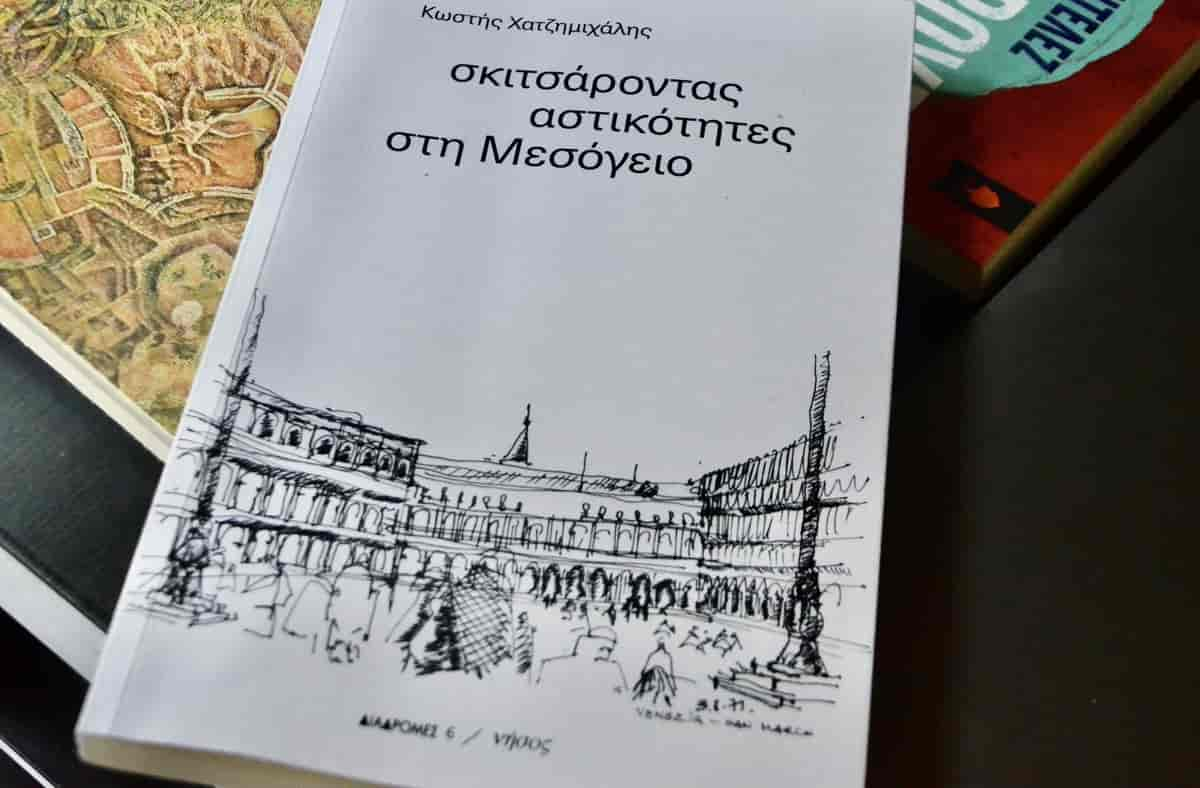About 15 days ago I received a notification from the well-known architect-professor of AUTh and Harokopio University Kostis Chatzimichalis for the publication of his book "Sketching urbanities in the Mediterranean" who, among other things, as he wrote to me, had a reference to me. Arriving from the island, my first job was to get it and enjoy it, already knowing some of his previous books, but also out of curiosity, to reveal what connected me to the author.
Ο Kostis Chatzimichalis is his peer teacher Harokopio University and teaches in the postgraduate program of the Department of Geography. He has taught at Department of Architecture of AUTh (1980-1997), in the Department of Geography of Harokopio (1997-2012) and, as a visiting professor, in universities in Europe, the USA and Australia. His recent books include: Geography issues suitable for non-geographers (island 2016), Debt crisis and land grabbing (KPSM 2015, reissue: 2017, and German edition Westfalishes Dampfboot) and Crisis Spaces. Structures, Resistance and Solidarity in Southern Europe (Routledge 2017).
The author begins his prologue without twists:
"I have been sketching urbanities since 1964. I have a closet full of blocks, apart from the lost ones, like the one in San Ciminiano… In my first transmigration, as an architect, it was part of my daily work. Later as a social scientist, sketches were the only almost systematic contact with architecture… I like to look for peculiarities and surprises in urban areas, in “City rooms” as Jacob Bakema used to say. I rest with a coffee in a square, the black marker pad, always in my backpack, on every trip. Of course I also take photos, but it is another thing to turn the image into a sketch: to filter and emphasize what you want, to "steal" the subject a little, to take notes on the proportions, to put dimensions. "
From the first page, confessions flow, texts that flow effortlessly and sketches that fascinate, attitudes and thoughts so familiar with those who have similar concerns!
At some point he makes a very interesting reference, which refers to the image of the landscapes and what is hidden behind them, and tries to pull the "curtain" as he mentions ... ” … The connection of the image of urbanity, which I capture in the sketches with the daily life of the locals and the memories that are hidden in the materiality of the space, behind the beautiful proportions of the facades, for the conflicts for money, the diseases, the intrigues, the toil and misfortune of the inhabitants ”…
There at the end of the book, on page 156 and in the chapter "Cafes, patisseries and taverns" at the beginning of the article, I saw the “A small gift to George Pittas for the unique album, The Cafes of Greece " and my question was answered, as I imagine that the need for retribution comes from some moments of pleasure that I offered him in my absence, in one or more of the cafes of my research.
In this chapter are presented sketches, cafes from Greece, such as the one above in the square of Chora of Amorgos, but also from all over the Mediterranean. So Kostis Chatzimichalis writes: " For most of the sketches I was looking for somewhere to sit and what more suitable than a coffee, a dessert or a well-cooked dish in a place I liked. So it is not surprising that in many sketches, in the foreground there are tables... "
In two words, the book "Sketching Urbanities in the Mediterranean" is enjoyable, because simply, it depicts the states of pleasure of the author when sketching he tried to decode the images and the urban landscapes that he observed.
No nostalgia for what is lost, 173 sketches in dozens of urban landscapes from ten Mediterranean countries (Morocco, Portugal, Spain, Southern France, Italy, Greece, Tunisia, Egypt, Turkey, Cyprus) and four of the "wider" Mediterranean (Austria, Hungary, the Netherlands, Belgium) hold paper the image of the place and the enjoyment of the moment, the qualities and the feeling of the familiar in the squares, in the streets, in the markets, in the taverns, in the cafes and the shipyards
In my turn, I also have a surprise for the author as some sketch photos that exist in his book, I already had them embedded in a personal archive and in fact in a prominent position. It came from a third-party study that had fallen into my hands for at least 40 years now, and concerned material taken from his study Kostis Chatzimichalis and A. Polychroniadis on "Structure and characteristics of the natural environment in Naxos" and was published in the edition Settlements in Greece in Architectural Issues edited by O. Doumanis and P. Oliver (1974).
Along with his both abstract and symbolic sketches, the author described with a poetic quality the emotions caused by the marches in the Castle of Naxos:
"The road is a penetrating element of the environment, and not a catalyst. Walking in Chora, you meet a constant change of impressions. You pass through narrow, under canopies. The wall next to you stops being a wall and becomes a garden or an opening to the view. You go up or down the hill, you see the sea, or you hear it, or you even breathe its aroma… This successive change of impressions comes from a constant change of environment. "Sometimes it is' near ', such as the dimensions of the road, the placement of the buildings, the color, the texture, and other times'' distant ', such as the view and the orientation."
I wish with all my heart, good luck the book, and wishes for many more sketches in enjoyable and full of juices and beauty journeys.











